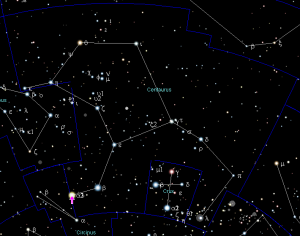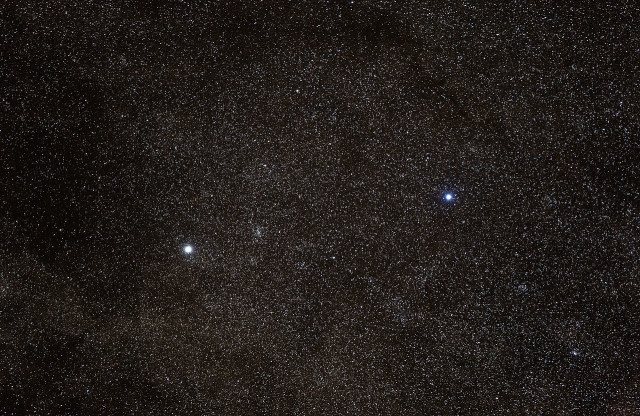Alpha Centauri is the nearest star system to the Sun, located at a distance of only 4.37 light years or 1.34 parsecs from Earth. It is the brightest star in Centaurus constellation and the third brightest star in sky. It is only slightly brighter than Arcturus in Boötes constellation and Vega in Lyra. The star is also known as Rigil Kent, Rigil Kentaurus, or Toliman.
Alpha Centauri is a binary star system consisting of Alpha Centauri A and Alpha Centauri B. It is sometimes referred to as Alpha Centauri AB (α Cen AB).
The combined apparent magnitude of the system is –0.27, making it the brightest star seen from Earth other than Sirius (-1.46) in the constellation Canis Major and Canopus (-0.72) in Carina.
The components Alpha Centauri A and B form a visual binary star, which means that they appear as a single star to the unaided eye and cannot be resolved without binoculars or a telescope. They are, however, very easily resolved in binoculars and small telescopes.
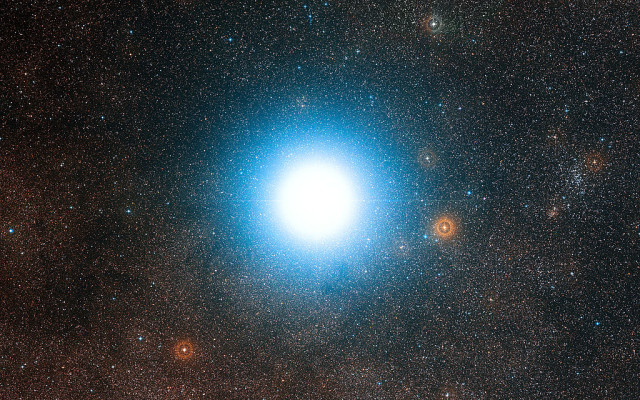
This wide-field view of the sky around the bright star Alpha Centauri was created from photographic images forming part of the Digitized Sky Survey 2. The star appears so big just because of the scattering of light by the telescope’s optics as well as in the photographic emulsion. Alpha Centauri is the closest star system to the Solar System. Image: ESO/DSS 2
The system may have a third component, Alpha Centauri C (Proxima Centauri), which is believed to be associated with the binary system, but is located an an angular separation of 2.2° to the south-west of Alpha Centauri AB, at a distance much greater than that between components A and B. The distance is about four times the angular diameter of the full Moon and roughly half the distance from Alpha to Beta Centauri.
If it were visible to the unaided eye, Proxima Centauri would appear as a separate star, not as part of the Alpha Centauri system. There is still no direct evidence that Proxima has an elliptical orbit, which is typical of binary star systems.
The estimated age of the Alpha Centauri system is between 4.5 and 7 billion years, which makes the stars slightly older than the Sun.
The name Rigil Kent, or Rigil Kentaurus, is the romanization of the Arabic Rijl Qanṭūris, derived from the phrase Rijl al-Qanṭūris, meaning “the foot of the Centaur.” The star marks the foot of the centaur represented by Centaurus constellation.
Alpha Centauri’s other proper name, Toliman, may come from the Arabic al-Ẓulmān, which means “the ostriches.”
Alpha Centauri is circumpolar south of latitude 29°S, which means that it never sets below the horizon for observers in those latitudes.
It is one of the Southern Pointers, stars that point the way to the Southern Cross and help observers distinguish it from the False Cross, a fainter asterism also found in the southern sky. The line from Alpha to Beta Centauri, also known as Hadar or Agena, points directly to Crux constellation.
The Alpha Centauri system lies too far south to be seen from mid-northern latitudes. It can be seen near the southern horizon in the northern summer in latitudes between 29°N and the equator.
Distance
Alpha Centauri lies at a distance of 4.37 light years from Earth. This translates into 277,600 astronomical units, or 41.5 trillion kilometres, or 25.8 trillion miles. The two unmanned probes, Voyager 1 and Voyager 2, launched in 1977, are not headed toward the system, but if they were, it would take them tens of thousands of years to get there. To reach the system within a human lifetime, one would need to travel at one-tenth of the speed of light.
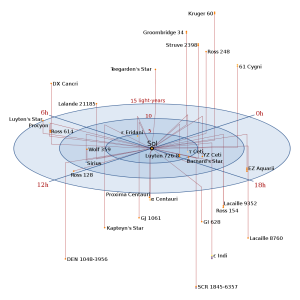
A spatial representation of every star within 14 light-years of Sol. There are 32 known stars in this region, including Sol. The stars are coloured according to the spectral type, which may not reflect the actual colour. If a star is double or triple the stars are shown stacked vertically: the actual position is the star closest to the centre plane. The stars on this map may not all be visible to the unaided eye, as many are dwarf stars. Some of this information may be preliminary and not entirely accurate as a result. The coordinate system is right ascension and declination. Hours of RA are marked, as well as distance in multiples of 5 light-years. Image: DavidDarling.info
The Scottish astronomer Thomas James Henderson was the first to calculate the distance to Alpha Centauri using the parallax method between April 1832 and May 1833 from the Royal Observatory at the Cape of Good Hope. He did not publish his findings until 1839 because he thought the results were too large to be accurate. Once Friedrich Wilhelm Bessel released his findings for the star 61 Cygni, also using the parallax method, in 1838, Henderson decided to publish his own. Technically, Alpha Centauri was the first star to have its parallax measured, but since it was not recognized first, it is generally considered as the second, after 61 Cygni in Cygnus constellation.
Henderson also realized that the components of the Alpha Centauri system displayed a significantly high proper motion. The system’s motion was later discovered to be about 6.1 arcminutes each century, or 61.3 arcminutes each millennium. This means that Alpha Centauri moves about 1.02° across the sky every 1,000 years. 6.1 arcminutes is roughly a fifth of the diameter of the full Moon, and 61.3 arcminutes is about twice the Moon’s diameter.
Based on the system’s proper motions and radial velocities, it will keep becoming brighter and pass to the north of Crux constellation before moving to the northwest. By the year 29,700, Alpha Centauri will be at a distance of 3.26 light years and reach a maximum visual magnitude of -0.86, close to the current magnitude of Canopus. However, even at its closest approach , the star’s apparent magnitude will not surpass that of the brightest star in the sky, Sirius. Sirius will also brighten over the next 60,000 years and continue to be the brightest star for about 210,000 years.
After it has made its closest approach to the solar system, Alpha Centauri will gradually move away, until it reaches a final vanishing point in about 100,000 years.
Planets
The Alpha Centauri system may contain at least one planet, discovered in the orbit of Alpha Centauri B. The planet, if confirmed, will be the closest known exoplanet to Earth.
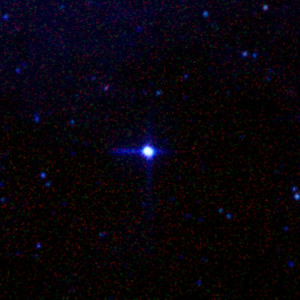
The nearby star system Alpha Centauri. Photo taken by Midcourse Space Experiment spacecraft. Image: MSX/IPAC/NASA
The star system has been the target for searches for decades because of its proximity to Earth, but previous studies have been unsuccessful in finding a planet orbiting any of the stars. The first planet was discovered on 16 October 2012 by researchers at the Observatory of Geneva and the Centre for Astrophysics of the University of Porto. They used the radial velocity technique. It took three years of observations to make an analysis. The planet is not in the habitable zone, as it orbits too close to the star, at only 0.04 astronomical units.
Designated Alpha Centauri Bb, the planet has a mass at least 13 percent more than Earth’s and a surface temperature of 1,500 K (1,200°C), which makes it too hot to support life. For comparison, the hottest planet in the solar system, Venus, has a surface temperature of only 735 K (462°C). Alpha Centauri Bb orbits the star with a period of 3.2357 days at a distance of 6 million kilometres, which is only about 4 percent of the distance between the Earth and the Sun.
It is possible that there are other planets orbiting Alpha Centauri A and B, but the searches have so far failed to find any gas giants or brown dwarfs.
For a planet to be in the habitable zone of Alpha Centauri A, it would need to orbit the star at a distance of around 1.25 astronomical units, which is roughly halfway between the distances of Earth’s and Mars’ orbits around the Sun. At this distance, an Earth-like planet would have a similar temperature and conditions for liquid water to exist.
The habitable zone for Alpha Centauri B would be a little bit closer to the star, at roughly 0.7 astronomical units, or 100 million kilometres, which is about the same distance as that between the Sun and Venus.
Alpha Centauri A (Rigil Kentaurus)
Alpha Centauri A has 110 percent of the Sun’s mass and 151.9 percent of its luminosity. It is a main sequence star similar to the Sun, with a radius about 23 percent larger. It belongs to the spectral class G2 V.
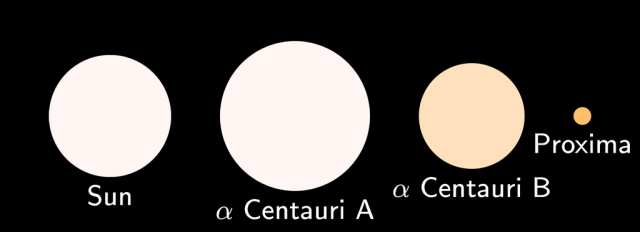
A comparison of the sizes and colors of the stars in the Alpha Centauri system with the Sun. Image: David Benbennick
The star has a projected rotational velocity of 2.7 and a rotational period of about 22 days, which makes it a slightly faster spinner than the Sun, which takes 24.47 days to complete a rotation.
Alpha Centauri A is the fourth individual brightest star in the night sky, with an apparent magnitude of -0.01, only slightly fainter than Arcturus (-0.04), the brightest star in Boötes constellation. The star has an absolute magnitude of 4.38.
Alpha Centauri B (Toliman)
Alpha Centauri B has 90 percent of the Sun’s mass and 44.5 percent of its luminosity. It is a main sequence star with the stellar classification K1 V, which makes it more orange in colour than Alpha Centauri A, which is yellowish. The star has a radius about 14 percent smaller than the Sun.
Alpha Centauri B has a projected rotational velocity of 1.1 and an estimated rotational period of 41 days. Even though it is not as luminous as Alpha Centauri A, the star emits more energy in X-ray. If it could be seen as a star separate from Alpha Centauri A, star B would be the 21st individual brightest star in the sky, with an apparent magnitude of 1.33. It has an absolute magnitude of 5.71.
Alpha Centauri C (Proxima Centauri)
Alpha Centauri C, better known as Proxima Centauri, is the nearest known individual star to the Sun, at a distance of 4.24 light years.
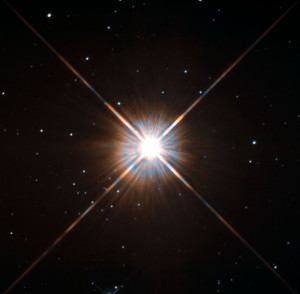
Proxima Centauri lies in the constellation of Centaurus (The Centaur), just over four light-years from Earth. Although it looks bright through the eye of Hubble, as you might expect from the nearest star to the Solar System, Proxima Centauri is not visible to the unaided eye. Its average luminosity is very low, and it is quite small compared to other stars, at only about an eighth of the mass of the Sun. However, on occasion, its brightness increases. Proxima is what is known as a “flare star”, meaning that convection processes within the star’s body make it prone to random and dramatic changes in brightness. Image: ESA/Hubble & NASA
It is likely gravitationally bound to Alpha Centauri AB and lies at a distance of 0.24 light years, or 0.06 parsecs (13,000 astronomical units), or 2.2 trillion kilometres from the main pair. Unlike Alpha Centauri AB, Proxima Centauri is too faint to be seen with the unaided eye.
Proxima Centauri belongs to the stellar class M5 Ve or VIe, which means that it is red in colour and either a small main sequence star (V) or a subdwarf (VI) with emission lines.
The star has a mass of about 0.123 solar masses. It is classified as a flare star, and its brightness can sometimes suddenly increase to magnitude 11.0 or 11.09. The star has an absolute magnitude of 15.53.
If Proxima Centauri is gravitationally bound to the Alpha Centauri system, it orbits the binary pair with a period between 100,000 and 500,000 years.
Star system
Alpha Centauri A and Alpha Centauri B orbit a common centre every 79.91 years. The distance between the stars varies from 35.6 astronomical units (5.3 billion kilometres) to 11.2 astronomical units (1.67 billion kilometres). The distances are roughly equivalent to those between the Sun and Pluto and between the Sun and Saturn. The angular separation between Alpha Centauri A and Alpha Centauri B varies from 2 to 22 arcseconds. The total mass of the binary star system is about 2 solar masses.
Facts
Alpha Centauri was brought to the attention of Europeans by the English explorer Robert Hues in his Tractatus de Globis (1592), along with two other bright southern stars, Canopus in Carina and Achernar in Eridanus.
Hues wrote, “Now, therefore, there are but three Stars of the first magnitude that I could perceive in all those parts which are never seene here in England. The first of these is that bright Star in the sterne of Argo which they call Canobus. The second is in the end of Eridanus. The third is in the right foote of the Centaure.”
The Chinese know Alpha Centauri as the Second Star of the Southern Gate, referring to the Southern Gate asterism that it forms with Epsilon Centauri.
Australian aboriginal Boorong people in northwestern Victoria call Alpha and Beta Centauri Bermbermgle. The stars represent two brothers who heroically defeated the Emu, represented by the Coalsack Nebula, a famous dark nebula located in Crux constellation.
Since Alpha Centauri can only be seen from the southern latitudes, there are no Greek or Roman myths associated with it, and it lacks historical and metaphorical significance in northern cultures. However, because of its proximity to us, the Alpha Centauri system is a huge part of popular culture, with numerous references in the works of science fiction, from novels including Arthur C. Clarke’s The Songs of Distant Earth, Isaac Asimov’s Foundation and Earth, William Gibson’s Neuromancer, and Philip K. Dick’s Clans of the Alphane Moon to episodes of Star Trek and Babylon 5, to films like Lost in Space, Impostor, Avatar, Transformers, and Guardians of the Galaxy. The system is also referenced in a number of games like Civilization, Frontier: Elite II and Frontier: First Encounters, Alien Legacy, Terra Nova: Strike Force Centauri, Colony Wars, Earth & Beyond, Mass Effect 2, and Sid Meier’s Alpha Centauri.
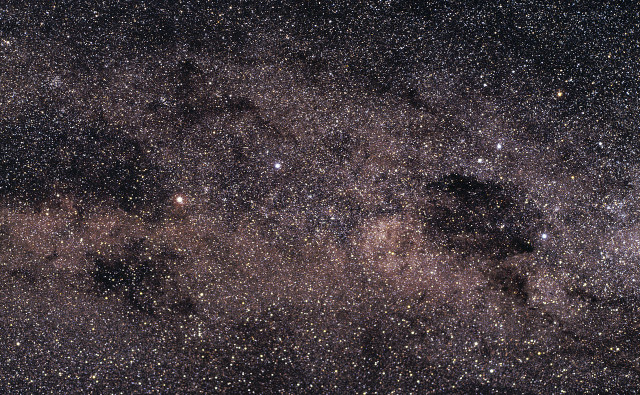
In a wide-field image obtained with an Hasselblad 2000 FC camera by Claus Madsen (ESO), a region around the Southern Cross, seen in the right of the image (Kodak Ektachrome 200, 70 min exposure time). Alpha Centauri is the bright yellowish star seen at the middle left, one of the “Pointers” to the star at the top of the Southern Cross. Image: ESO, Claus Madsen
The first astronomer to recognize Alpha Centauri as a binary star system was the Jesuit priest Jean Richaud in Puducherry in India. His discovery of the star’s binary nature happened by accident, while he was observing a passing comet. At the time, the only other binary star known was Acrux, the brightest star in the constellation Crux.
The South African astronomer William Stephen Finsen calculated Alpha Centauri’s estimated orbit by 1926.
The nearest known star system to Alpha Centauri is Luhman 16 in Vela constellation, lying at a distance of 3.6 light years.
A hypothetical observer in the Alpha Centauri system would see the sky as very similar to ours, except that the brightest star in Centaurus constellation would be missing. The Sun would appear as a magnitude 0.5 star in the direction of the constellation Cassiopeia, near the star Epsilon Cassiopeiae. Cassiopeia’s W would look like a /\/\/. Sirius would be much closer to Betelgeuse in Orion constellation, appearing less than a degree away, but it would be the brightest star in the sky when observed from Alpha Centauri, too.
Alpha Centauri
Constellation: Centaurus
Distance: 4.366 light years (1.339 parsecs)
Orbital period: 79.91 years
Designations: Alpha Centauri, Rigil Kentaurus, Rigil Kent, Toliman, Bungula, FK5 538, CP(D)−60°5483, GC 19728, CCDM J14396-6050
Alpha Centauri A: Alpha-1 Centauri, GJ 559, HR 5459, HD 128620, GCTP 3309.00, LHS 50, SAO 252838,HIP 71683
Alpha Centauri B: Alpha-2 Centauri, GJ 559 B, HR 5460, HD 128621,LHS 51, HIP 71681
Alpha Centauri A
Coordinates: 14h 39m 36.4951s (right ascension), -60°50’02.308” (declination)
Visual magnitude: -0.01
Absolute magnitude: 4.38
Spectral class: G2 V
Mass: 1.100 solar masses
Radius: 1.227 solar radii
Luminosity: 1.519 solar luminosities
Temperature: 5,790 K
Age: 6 Gyr
Alpha Centauri B
Coordinates: 14h 39m 35.0803s (right ascension), -60°50’13.761” (declination)
Visual magnitude: +1.33
Absolute magnitude: 5.71
Spectral class: K1 V
Mass: 0.907 solar masses
Radius: 0.865 solar radii
Luminosity: 0.500 solar luminosities
Temperature: 5,260 K
